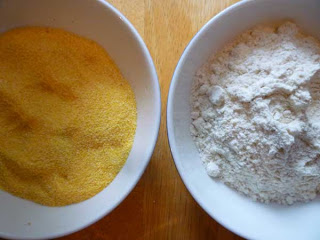I have a recipe that calls for a mix of corn and wheat flours, but my local grocery stores (in the south east US) only carry corn meal.
- What is the difference between corn flour and corn meal?
- Can I safely use corn meal in the place of corn flour?
I have a recipe that calls for a mix of corn and wheat flours, but my local grocery stores (in the south east US) only carry corn meal.
The difference between the two can be seen below (the post it is from is an experiment comparing corn meal and flour used in anadema bread):

The corn flour is the white, finer ingredient on the right. The first obvious difference is that the texture will differ between the two. The second is that it would have different uses. Both would be effective at displacing gluten-containing flours (as in, neither would be helpful in gluten formation).
In terms of substitution, however, corn meal is likelier substituted by something like semolina flour and corn flour is likelier better substituted by quinoa or garbanzo bean flour.
Both are ground corn (maize, as they would have it in Europe). The difference is that corn flour is usually ground to a much finer texture than cornmeal.
While in some contexts (such as breading chicken), they can both be used, you will get different textural results. In general, you want to use the right product.
For example, corn muffins are normally made with corm meal, and if made with corn flour, would be much denser and without the mouthfeel the individual cornmeal granuals provide.
Update: in some places, polenta is another term for corn meal (as well as for the porridge or mush made from the corn meal).
Masa is dried lye-treated corn, which has been ground. It is used widely in southwestern, central, and south American cuisines, including for the iconic corn tortillas, and for tamales.
Possible definitions are available in a recent publication of Annals of New York Academy of Sciences - look for table 4.
Corn meal is listed as particle size from 300 to 600µm, with fat content of 1.8%, while corn flour is listed as particle size less than 212 µm, with fat content of 2.7%.
They also mention various definitions in US CFR 137, which provide indirect particle size definitions in terms of how much of the product will pass through various types of sieves/cloth/gauze.
Corn flour could either be finely ground untreated (the alkaline process) corn or powdered starch (usually corn or sometime wheat based) depending where you live
The only way to tell is to check the recipe to which is required. If it is a bulk ingredient like flour for bread volumes, then is probably is finely ground untreated corn. If it is one or two spoons mixed into a liquid and then heated, then is probably is being used as a thickener and they are referring to the powdered starch
In many countries of the world you generally cannot purchase finely ground untreated corn, but can readily purchase corn derived starch
Please post a link to the recipe if you are unsure
In very simple words difference between Cornflour and Maize flour is Corn flour is the Starch part of Maize flour.. That means From Maize flour the starch and protein is separated and the fine smooth part is starch as itvis in Wheat flour when Starch and protein is separated...the starch part is called as Mayeda in Hindi and the protien part is called as Ravaa in Hindi.
By:Izzuddin Saify